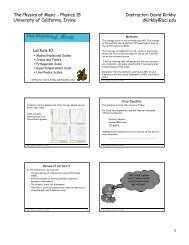The Physics of Music - Physics 15 University of California, Irvine ...
The Physics of Music - Physics 15 University of California, Irvine ...
The Physics of Music - Physics 15 University of California, Irvine ...
You also want an ePaper? Increase the reach of your titles
YUMPU automatically turns print PDFs into web optimized ePapers that Google loves.
<strong>The</strong> <strong>Physics</strong> <strong>of</strong> <strong>Music</strong> - <strong>Physics</strong> <strong>15</strong><br />
<strong>University</strong> <strong>of</strong> <strong>California</strong>, <strong>Irvine</strong><br />
Instructor: David Kirkby<br />
dkirkby@uci.edu<br />
Resonance and Damping<br />
Why doesn’t the swing keep getting higher and higher<br />
until you are doing circles<br />
An idealized resonant response builds an unlimited amount<br />
<strong>of</strong> energy.<br />
Realistic resonant systems do not do this because <strong>of</strong><br />
dissipation, i.e., they are damped.<br />
Compare the motion <strong>of</strong> the swing when it is pumped at the<br />
right frequency but with different amounts <strong>of</strong> damping.<br />
Resonant Frequencies<br />
A physical system may have one or more frequencies at<br />
which resonances build up. <strong>The</strong>se are called resonant<br />
frequencies (or natural frequencies).<br />
<strong>The</strong> basic requirements for a system to be resonant are<br />
that:<br />
• It have well-defined and stable boundary conditions,<br />
• That it not have excessive damping.<br />
This means that most systems have at least one type <strong>of</strong><br />
resonance!<br />
Resonant frequencies are <strong>of</strong>ten in the audible range<br />
(about 20-20,000 Hz). Try tapping an object to hear its<br />
resonant response.<br />
<strong>Physics</strong> <strong>of</strong> <strong>Music</strong>, Lecture 5, D. Kirkby 7<br />
<strong>Physics</strong> <strong>of</strong> <strong>Music</strong>, Lecture 5, D. Kirkby 8<br />
A system may have more than one resonant frequency.<br />
We call the lowest resonant frequency the fundamental<br />
frequency. Any higher frequencies are called overtones.<br />
<strong>The</strong> playground swing has only one resonant frequency.<br />
Most <strong>of</strong> the systems responsible for generating musical<br />
sound have many resonances.<br />
We will see examples <strong>of</strong> systems with overtones later in<br />
this lecture. A familiar (non-musical) example occurs when<br />
different parts <strong>of</strong> a car rattle at certain speeds.<br />
Visualizing Resonance<br />
A resonance curve measures how much total energy builds<br />
up when a fixed (small) amount <strong>of</strong> energy is delivered<br />
periodically.<br />
It is described the the<br />
mathematical function:<br />
y(x) = 1/(1+x 2 )<br />
Energy Buildup<br />
too<br />
slow<br />
just right<br />
log(Driving Frequency)<br />
logarithmic axis!<br />
too<br />
fast<br />
http://www.2dcurves.com/cubic/cubicr.html<br />
<strong>Physics</strong> <strong>of</strong> <strong>Music</strong>, Lecture 5, D. Kirkby 9<br />
<strong>Physics</strong> <strong>of</strong> <strong>Music</strong>, Lecture 5, D. Kirkby 10<br />
Sidebar on Logarithmic Graph Axes<br />
Moving one unit to the right on a normal (linear) graph axis<br />
means add a constant amount.<br />
Moving one unit to the right on a logarithmic axis means<br />
multiply by a constant amount.<br />
Example: the exponential decay law (e.g., from damping)<br />
results in a decrease by a fixed fraction after each time<br />
interval.<br />
What would this look like if time is plotted on a<br />
logarithmic axis<br />
<strong>Music</strong>al notes (A,B,C,…,G) correspond to<br />
logarithmically-spaced frequencies.<br />
<strong>The</strong>refore a piano keyboard or a musical<br />
staff are actually logarithmic axes<br />
in disguise!<br />
Energy Buildup<br />
<strong>Physics</strong> <strong>of</strong> <strong>Music</strong>, Lecture 5, D. Kirkby 11<br />
<strong>Physics</strong> <strong>of</strong> <strong>Music</strong>, Lecture 5, D. Kirkby 12<br />
2





